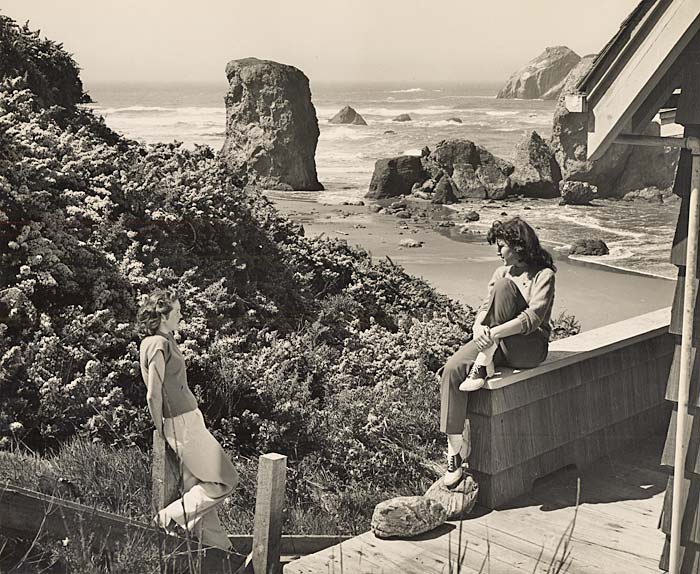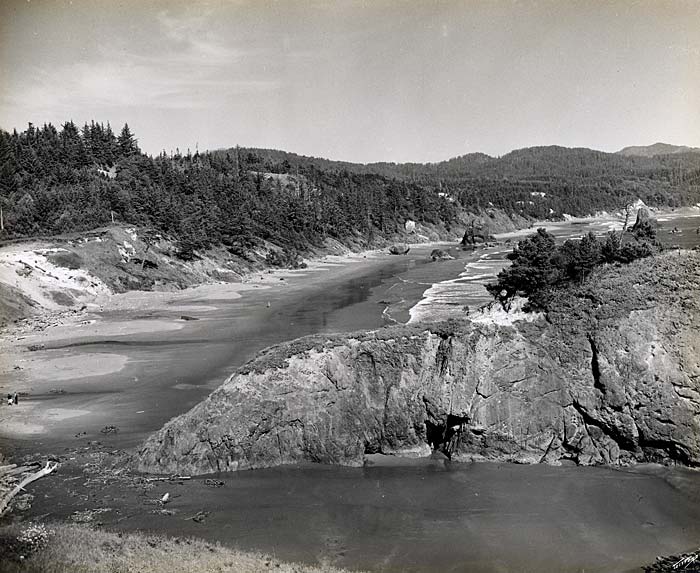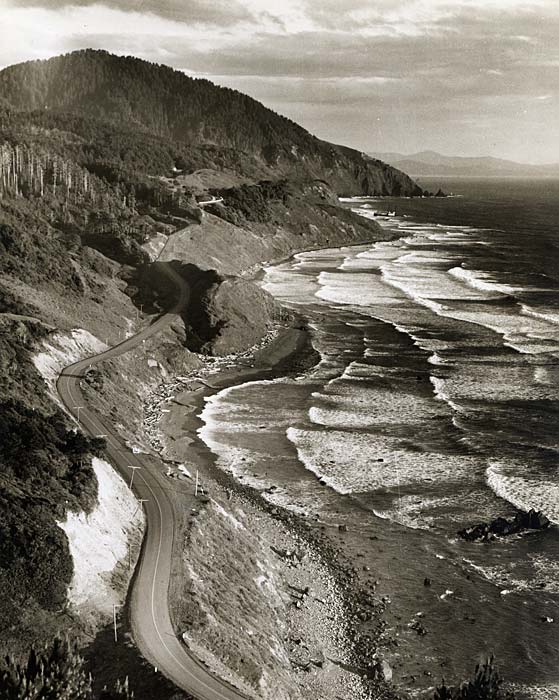 Cottage and rocks at Bandon (2484). Enlarge image.
Cottage and rocks at Bandon (2484). Enlarge image.
COQUILLE, 120.6 m. (60 alt., 2,732 pop.), on the Coquille River, is the seat of Coos County, a region where considerable dairying is carried on. Within the city limits it is possible to fish for several varieties of salmon and trout.
In years past, Coquille was very much a river town, dependent on boats for transport of people, goods, and mail. The boats lent a picturesque character to the town that is no longer evident in the highway era, but Coquille now desires to look as much like other towns as possible.
Coquille is at the junction with State 42.
RIVERTON, 126.7 m. (16 alt., 150 pop.), is a trade center for farmers who specialize in pea-raising. The pea-raising farms are recognized by their vine-covered trellises.
 Battle Rock near Port Orford (2150). Enlarge image.
Battle Rock near Port Orford (2150). Enlarge image.
The remnants of PARKERSBURG (R.), 134.8 m. (34 alt., 20 pop.), are across a meadow at the mouth of Bear Creek. Sawmills were installed in and near Parkersburg, beginning in 1867. Shipyards also played a role in the local economy. A successful fish canning operation began near the town in 1883, but the cannery was burned some years later.
BANDON, 138.5 m. (10 alt., 1,516 pop.), a resort town with a beach at the mouth of the Coquille River, with long cypress hedges, gleaming white lily beds, and gnarled pines, was known as the most beautiful town in southern Oregon until a disastrous fire swept in from the forests to the east and wiped it out. Reconstruction began in 1938 with federal aid and on plans prepared by the Oregon State Planning Board, which provides for a better arrangement of facilities, wide streets, recreational areas, and better educational facilities. Trees and grasses are being planted on the burned over environs, and the design of business structures is being controlled.
The town takes its name from Bandon, on Bandon River, County Cork, Ireland, which was the former home of George Bennett, one of the earliest settlers in the area. Bennett is also said to have imported the Irish furze, which in early spring yellows the sand hills along the highway southward. A thorny shrub, its pea-like flowers have an odor similar to that of coconut oil.
 Looking south from Port Orford (G654). Enlarge image.
Looking south from Port Orford (G654). Enlarge image.
Between the highway and the ocean, lies a series of dune-sheltered lakes. Stunted huckleberry is mingled with rhododendron and azalea plants. Pitcher plants also grow in this region. The variety "chrysamphora californica" is found only along the coast.
The valuable white Port Orford cedar (Lawson cypress), is seen frequently. It is now in particular demand for use in the manufacture of Venetian blinds. It also ranks high for use in boats.
LANGLOIS, 152.3 m. (88 alt., 250 pop.), is a dairymen's trade town. Sawmills are also in operation here.
At 153.4 m. is the junction with a dirt road.
Right here to FLORAS LAKE, 3 m., a small body of fresh water cut off from the sea by low sand dunes. On the shore of the lake is the site of Lakeport, a town that thrived briefly three decades ago on the supposition that a canal could be built between the sea and the lake, thus making possible an inland harbor. Lots were sold, houses built, and businesses established before a disturbing discovery was made: the lake was higher than the ocean. If the canal were dug, the lake would empty into the Pacific unless expensive locks were built. The dream, and the town, faded quickly. A few brush-grown walks and the crumbling foundation of a hotel are all that remain of Lakeport.
DENMARK, 154.8 m. (97 alt., 96 pop.), is the trading center of dairymen of Danish birth or descent. A fossil-bearing sandstone bed extends from here north to the mouth of the Coquille River.
 Mouth of Brush Creek at Humbug Mountain (2151). Enlarge image.
Mouth of Brush Creek at Humbug Mountain (2151). Enlarge image.
PORT ORFORD CEDAR STATE PARK, 157.7 m., extends along the highway for half a mile. It holds one of the fine stands of this tree.
SIXES, 160 m. (109 alt., 49 pop.), is on the banks of a small river of the same name noted for steelhead. Gold deposits once drew miners to the river.
At 161 m. is the junction with a gravel road.
Right on this road through rhododendron and azalea thickets and over lupine-covered hills to the CAPE BLANCO CATHOLIC CHURCH (L.), 4.4 m., now in ruins; bats cling to the altar and the glass in the pointed window frames is shattered. The church was built near the home of Patrick Hughes, Irish emigrant and pioneer settler. By the walk is the flower-matted site where Hughes was buried.
CAPE BLANCO LIGHTHOUSE, 5.5 m., stands on the most westerly point of Oregon. Bricks for buildings at the site were made from nearby clay deposits.
ELK RIVER, 161.7 m., is a narrow stream abounding in trout and salmon. Prosperous dairy farms operate in the area.